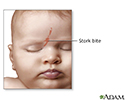Stork bite
Salmon patch; Nevus flammeus
A stork bite is a common type of birthmark seen in a newborn. It is most often temporary.
The medical term for a stork bite is nevus simplex. A stork bite is also called a salmon patch.
Causes
Stork bites occur in about one third of all newborns.
A stork bite is due to a stretching (dilation) of certain blood vessels. It may become darker when the child cries or the temperature changes. It may fade when pressure is put on it.
Symptoms
A stork bite usually looks pink and flat. A baby may be born with a stork bite. It may also appear in the first months of life. Stork bites may be found on the forehead, eyelids, nose, upper lip, or back of the neck. Stork bites are purely cosmetic and do not cause any symptoms.
Exams and Tests
Your health care provider can diagnose a stork bite simply by looking at it. No tests are needed.
Treatment
No treatment is needed. If a stork bite lasts longer than 3 years, it may be removed with a laser to improve the person's appearance.
Outlook (Prognosis)
Most stork bites on the face go away completely in about 18 months. Stork bites on the back of the neck usually do not go away.
When to Contact a Medical Professional
Your provider should look at all birthmarks during a routine well-baby exam.
Prevention
There is no known prevention.
References
Dinulos JGH. Vascular tumors and malformations. In: Dinulos JGH, ed. Habif's Clinical Dermatology: A Color Guide in Diagnosis and Therapy. 7th ed. Philadelphia, PA: Elsevier; 2021:chap 23.
Long KA, Martin KL. Dermatologic diseases of the neonate. In: Kliegman RM, St. Geme JW, Blum NJ, Shah SS, Tasker RC, Wilson KM, eds. Nelson Textbook of Pediatrics. 21st ed. Philadelphia, PA: Elsevier; 2020:chap 666.
Moon M, Guerrero AM, Li X, Koch E, Gehris RP. Dermatology. In: Zitelli BJ, McIntire SC, Nowalk AJ, Garrison J, eds. Zitelli and Davis' Atlas of Pediatric Physical Diagnosis. 8th ed. Philadelphia, PA: Elsevier; 2023:chap 8.
Review Date: 4/27/2023
Reviewed By: Linda J. Vorvick, MD, Clinical Professor, Department of Family Medicine, UW Medicine, School of Medicine, University of Washington, Seattle, WA. Also reviewed by David C. Dugdale, MD, Medical Director, Brenda Conaway, Editorial Director, and the A.D.A.M. Editorial team.




